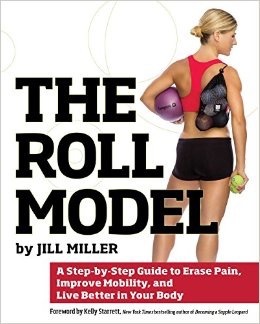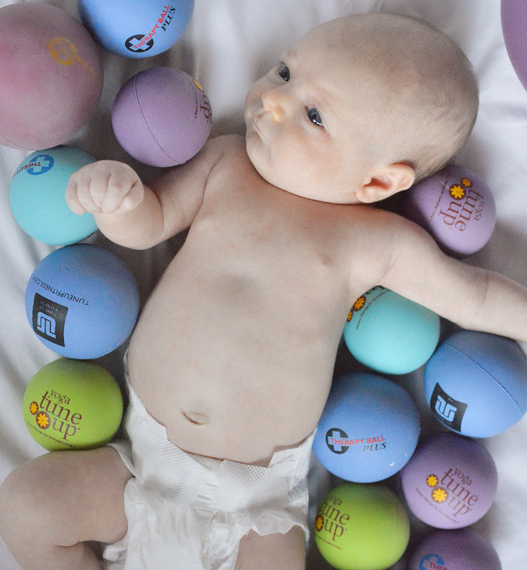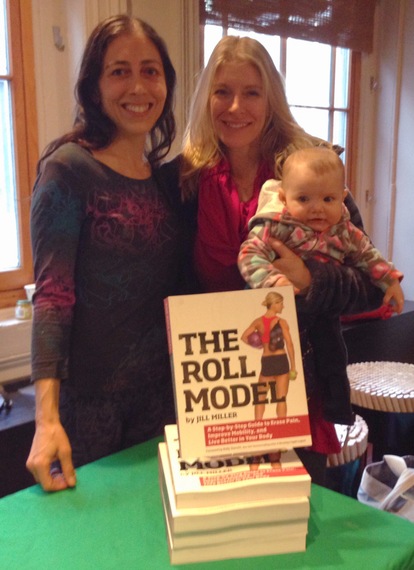At a glance, The Roll Model, a Step-by-Step Guide to Erase Pain, Improve Mobility, and Live Better in Your Body, by Jill Miller, is a beautiful, well-researched and catalogued book, filled with simple yet detailed descriptions, instructions, and easily-referenced photos of Jill and others rolling colorful, pliable balls over, on, and around almost every part of their bodies at seemingly every conceivable angle yet in targeted and precise ways. The book has a heft and scope that feels comprehensive without being overwhelming. In depth, The Roll Model is nothing less than the "step-by-step guide to erase pain, improve mobility, and live better in your body" that it promises to be, containing material that addresses the needs of a broad spectrum of people ranging from CrossFit athletes, bodybuilders and vinyasa yogis, to people with injuries and serious illnesses, pregnant women, babies, and even dogs. Working with pliable, grippy balls that treat rather than traumatize tissue the way that unyielding tennis balls might, The Roll Model maps out self-treatment plans that address the body's critical blind spots where the habits of modern life, including prolonged computer use, poor posture, ill-conceived fitness regimes, and stress have conspired to cause pain injury, and, ultimately, disease, and promises to improve mobility and quality of life for both athletes and people living with and recovering from illness.
When I first met The Roll Model's author, Jill Miller, over a decade ago, she was teaching a yoga workshop like no other I had ever attended, and her precise instruction peppered with anatomical understanding was intriguing to me as a holistic ob/gyn who treats female pain and prescribes movement. I invited Jill to come and teach at my studio in NYC, Lila Yoga, Dharma & Wellness, and she accepted. During her signature Core Integration workshop -- before she created her Coregeous Balls -- we rolled up small towels "like bagels" and lay belly down on them, moving them to 3 different positions over the course of many minutes, serenaded by Jill's detailed descriptions about the layers of tissues we were feeling: the muscles of the anterior abdominal wall, the enteric nervous system, or "second brain," of our gut, and how it related to our emotions. Jill's "Yoga Tune Up" approach, as she calls it, makes sense to me, particularly as the popularity of challenging vinyasa yoga classes as a fitness alternative with a glamorous twist continues to soar. In the context of modern, movement-deficient, stressful lifestyles, "opening" hips and doing deep unsupported backbends, not to mention chaturangas, even with but especially without proper instruction, may risk pelvic floor dysfunction, hip and shoulder injuries, and low back pain. In 1998, I remember my own hamstring tendon ripping vividly: the teacher guiding the class at most popular vinyasa yoga studio in NYC at the time told me that it was probably scar tissue breaking up and to go deeper into a split. As I did, I felt more hamstring tendon fibers pop. Pain, restricted movement, and pelvic instability followed. Here is what that teacher has to say about it, years later: "I was young and still so new. It is horrifying to me sometimes when I revisit how much trust people put in me." Many of my patients continue to tell me that they have been warned by various professionals to avoid physical activities such as yoga or pilates for fear of reinforcing damaging and inefficient patterns of movement and exacerbating pain. The problem with that is that once tissue gets sticky due to ongoing stress and inflammation, not moving makes it even more difficult to unstick. Tissue needs to glide. Movement involving ball rolling, properly applied, can help tissue regain and maintain resilience, promoting multiple physiological benefits. The Roll Model makes it clear and explains how.
As yoga's deeper methods and practices were increasingly diluted to expand its scope, I addressed my own disillusionment by going up to the Omega Institute in Rhinebeck, NY to study Anatomy of Asana with the obscure, brilliant, masterful, and now reluctantly famous Glenn Black, who is Jill Miller's mentor, acknowledged reverently in the introduction to The Roll Model. During the first couple of days of Anatomy of Asana, Glenn paced the room during deceptively simple yet intensely demanding poses and "remedial exercises," reminding us that there was still time for us to go to the Omega registration office and switch into one of the other courses. After a week with Glenn, I went to visit my mother, who worries about osteoporosis, and she immediately exclaimed: "You look taller!" Vinyasa yoga never did that. I have sometimes referred to Jill as "the oracle of Glenn" as she has catalogued and reinterpreted some of Glenn's material in a way designed to actively engage the public, referencing Jane Fonda and making early "garage band" yoga "tune up" videos while living in Los Angeles. Jill speaks in her workshops on a more personal level of how working with Glenn helped her to cue stability in her own hyperflexible body, weaving personal stories and anatomical insights into her instructions while targeting ranges of motion and blind spots that are quite simply missing from major yoga styles, calling it Yoga Tune Up. I remember one of her early ball-oriented workshops: I jokingly called it not just a "yoga tune up" but a "jump start," because the workshop had such a profound effect on reorienting my physiology via structural changes.
The Roll Model provides detailed instructions for portable self-care illustrated by beautiful photographs and intriguing information. As a doctor who seeks to inspire my patients to move and care for their bodies well, I appreciate the personal stories of embodiment and empowerment sprinkled throughout the book. Jill describes working with clients with conditions ranging from connective tissue diseases, to postsurgical recovery, and even recovering from her own, medically-caused pregnancy loss and becoming pregnant again at age 41, using her Therapy Balls. Jill Miller has an uncanny ability to synthesize, catalogue and present fitness and yoga material in a way that is both engaging and meaningful. The Roll Model is a product of her hard work, dedication, research, and integration. The therapy balls have already taken on a life of their own and become an appealing fitness and travel tool.


